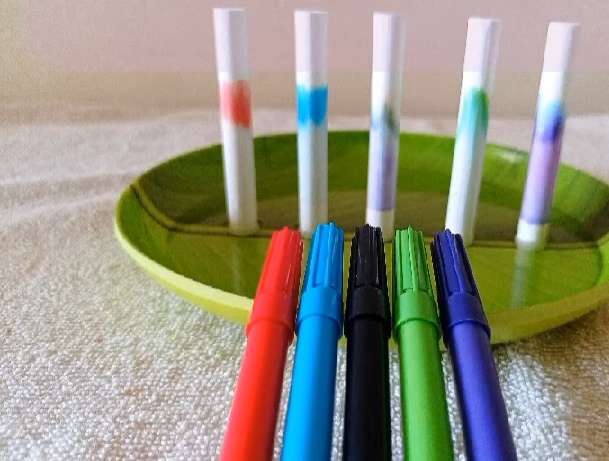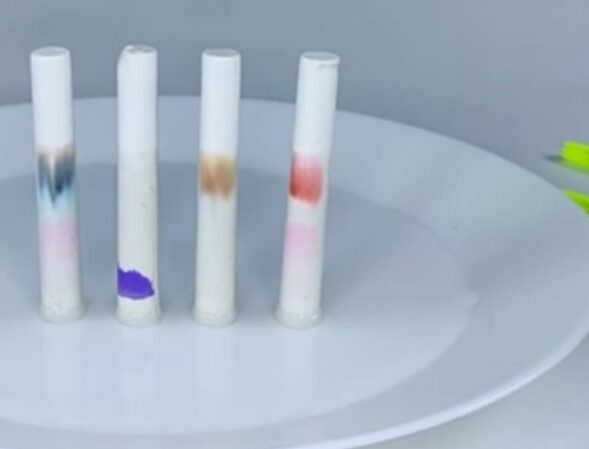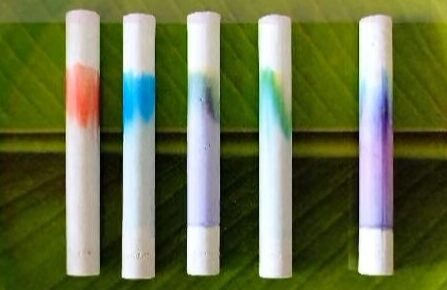Separating Pigments: Lab Experiment
Have you ever wondered how plants get their vibrant colors or what makes a flower petal so strikingly beautiful? The answer lies in pigments, natural compounds that absorb and reflect light. With a simple and engaging lab experiment called chalk chromatography, you can uncover the hidden colors within plant leaves, flowers, or food dyes. This hands-on activity is perfect for students, teachers, or anyone curious about the science of color. Let’s walk through the steps to conduct this fascinating experiment!

What is [Calcium Carbonate] Chalk Chromatography?
Chromatography is a method used to separate components within a mixture. In chalk chromatography, a piece of chalk serves as the stationary phase, while a solvent, such as rubbing alcohol, moves through it, carrying different pigments at varying speeds. This movement causes the individual colors within the mixture to become visible, revealing its composition. Since chalk is primarily made of calcium carbonate, it functions as an adsorbent in this technique, helping to retain and separate the substances effectively.
Procedure
This experiment demonstrates chromatography using chalk as the stationary phase and water or alcohol as the mobile phase. In chalk chromatography, Different pigments travel at different rates, allowing them to be separated. This simple technique is useful for identifying color components in inks and dyes.
Material requirements
- White chalk sticks: Plain, non-coated chalk works best.
- Solvent: Rubbing alcohol, acetone, or a mix of petroleum ether and acetone.
- Plant material: Fresh spinach leaves, kale, or flower petals.
- Tools: Mortar and pestle, small jars or cups, dropper, plastic wrap, and a ruler.
- Safety gear: Gloves and safety goggles.

Instructions
1. Prepare the Pigment Extract for chalk chromatography
- If using plant material, tear a few leaves or petals into small pieces.
- Grind them in a mortar and pestle with a teaspoon of solvent to release the pigments.
- Strain the liquid into a small container using a coffee filter or cheesecloth.
2. Apply the Pigment to the Chalk
- Use a pencil to draw a faint line about 1 cm from the tip of the chalk.
- Using a dropper, carefully place a small drop of the pigment extract on the line. Let it dry, then repeat 2–3 times to concentrate the pigment.
3. Set Up the Chromatography Chamber
- Pour about 0.5 cm of solvent into a small jar or cup.
- Place the chalk vertically in the jar, ensuring the pigment spot is just above the solvent level.
- Cover the jar with plastic wrap to slow down solvent evaporation.
4. Observe the Separation in chalk chromatography
- As the solvent travels up the chalk, it will carry the pigments with it.
- Different pigments will separate based on their solubility and adhesion to the chalk. For example, spinach may show green chlorophyll, yellow xanthophylls, and orange carotenes.
5. Dry and Analyze
- Once the solvent is about 1 cm from the top of the chalk (10–15 minutes), remove the chalk and let it dry.
- Observe the distinct bands of color. Measure the distance each pigment traveled and compare it to the solvent front to calculate Rf values (retention factors).
Chalk chromatography works because pigments have different properties. Some dissolve more easily in the solvent and travel faster, while others stick to the chalk and move more slowly. The porous surface of the chalk provides an ideal medium for separation, making this experiment both simple and effective.
Tips for Success
- Use Fresh Samples: Fresh plant material yields better results than dried leaves.
- Avoid Overloading: Too much pigment can cause smudging. Apply small, concentrated drops.
- Experiment with Solvents: Try different solvents to see how they affect pigment separation.
- Compare Samples: Test different plants or food dyes to see how their pigment profiles differ.
Safety Precautions
- Work in a well-ventilated area.
- Proper handling of solvents is essential to ensure safety and environmental protection.
- Work in a well-ventilated area to avoid inhaling harmful fumes, and keep solvents away from open flames or heat sources, as many are highly flammable.
- Store them in tightly sealed containers and label them correctly to prevent accidental misuse. If any solvent spills, clean it up immediately using appropriate absorbent materials and dispose of the waste safely.
- Always follow safety guidelines and regulations to minimize risks and maintain a safe working environment.
Retention Factors in Paper and Thin-Layer Chromatography
What is the Retention Factor (Rf)?
The retention factor (Rf) is a numerical value that represents how far a substance moves in a chromatography system relative to the movement of the solvent. It helps identify unknown compounds by comparing their Rf values with known substances.
The formula for Retention Factor (Rf):

- The solute/substance refers to the component being analyzed (e.g., ink, dye, amino acid).
- The solvent front is the highest point that the solvent reaches as it moves up the paper.
- The Rf value must come between 0 and 1 since the solute cannot move further than the solvent front.
Final Thought
- Chalk chromatography is a simple yet powerful experiment that reveals the hidden beauty of nature’s colors. Whether you’re a student, teacher, or science enthusiast, this lab activity offers a fun and educational way to explore the chemistry of pigments. So grab some chalk, gather your materials, and start uncovering the rainbow of colors hidden in everyday plants and dyes!
Share Your Results: Take photos of your chromatograms and share them online to inspire others. Science is all about discovery, so let’s celebrate the colors of the world together!
What is chalk chromatography?
What is the method of Chalk Chromatography?
Chromatography is a method used to separate components within a mixture. In chalk chromatography, a piece of chalk serves as the stationary phase, while a solvent, such as rubbing alcohol, moves through it, carrying different pigments at varying speeds. This movement causes the individual colors within the mixture to become visible, revealing its composition. Since chalk is primarily made of calcium carbonate, it functions as an adsorbent in this technique, helping to retain and separate the substances effectively.
Material requirements
White chalk sticks: Plain, non-coated chalk works best.
Solvent: Rubbing alcohol, acetone, or a mix of petroleum ether and acetone.
Plant material: Fresh spinach leaves, kale, or flower petals.
Tools: Mortar and pestle, small jars or cups, dropper, plastic wrap, and a ruler.
Safety gear: Gloves and safety goggles.
Why do colors separate in chalk chromatography?
What are the 4 types of chromatography?
1. Paper Chromatography
2. Thin-layer chromatography (TLC)
3. Gas Chromatography (GC)
4. High-Performance Liquid Chromatography (HPLC)
Is Calcium Carbonate [CaCO3] chalk used in Chalk Chromatography?
What is good chromatography practice?
Use High-Quality Materials – Select pure solvents, high-grade stationary phases, and properly prepared samples to improve separation efficiency.
Wear Protective Gear – Always use gloves, safety goggles, and lab coats to prevent direct contact with chemicals.
Work in a Well-Ventilated Area – Ensure proper airflow to reduce exposure to solvent fumes.
Apply Samples Correctly – Spot or load samples carefully to avoid smudging or uneven separation.
Use Proper Solvent Ratios – Choose the right solvent or solvent mixture to optimize separation and prevent excessive spreading.
Maintain Consistent Conditions – Keep temperature, humidity, and flow rates stable for reproducible results.
Handle Equipment with Care – Ensure chromatography paper, columns, or plates are clean and undamaged for precise outcomes.
Dispose of Chemicals Safely – Follow local guidelines for proper disposal of solvents and chemical waste.
Record Observations Accurately – Document separation patterns, distances traveled, and retention factors (Rf values) for analysis.
Store Chemicals Properly – Keep solvents and reagents in labeled, sealed containers away from heat and light to prevent degradation.
By following these best practices, chromatography experiments can be conducted efficiently, safely, and with high accuracy.
What are the different Types of Chromatography?
Chromatography encompasses several distinct methods for the separation and analysis of components within a mixture. Here are some different types of chromatography:
Gas Chromatography (GC): This method employs a gaseous mobile phase, ideal for analyzing volatile compounds. It is commonly used in environmental and chemical analysis.
Liquid Chromatography (LC): Utilizing a liquid as the mobile phase, it covers various techniques, including:
High-Performance Liquid Chromatography (HPLC): This technique enhances separation and purity through the application of high pressure.
Ultra-High-Performance Liquid Chromatography (UHPLC): An advanced form of HPLC offering even greater resolution and speed.
Thin-Layer Chromatography (TLC): It features a thin layer of adsorbent material on a flat substrate, where the mobile phase moves through capillary action, helping to separate compounds for qualitative analysis.
Column Chromatography: In this method, a column filled with stationary phase material allows for the separation of both liquid and gaseous samples.
Ion Exchange Chromatography: This technique sorts molecules based on their ionic charge, making it especially useful in protein purification and filtering charged contaminants from solutions.
Affinity Chromatography: This specialized method involves specific interactions between a target molecule and its binding partner, such as an enzyme or antibody, to achieve selective purification.
Size Exclusion Chromatography (SEC): Also known as gel filtration, this method separates molecules based on size, suitable for proteins, polymers, and other large biomolecules.
Supercritical Fluid Chromatography (SFC): Using supercritical fluids as a mobile phase, this approach bridges the characteristics of both gas and liquid chromatography, making it useful for various analyses.
Reversed-Phase Chromatography: A subtype of liquid chromatography where the stationary phase is hydrophobic, allowing for the separation of non-polar and moderately polar substances.
Each chromatography type has specific principles and applications, making it useful in a diverse array of fields such as chemistry, pharmaceuticals, biochemistry, and environmental science.
Chalk Chromatography
Chalk Chromatography is a method used to separate components within a mixture. In chalk chromatography, a piece of chalk serves as the stationary phase, while a solvent, such as rubbing alcohol, moves through it, carrying different pigments at varying speeds.
This movement causes the individual colors within the mixture to become visible, revealing its composition. Since chalk is primarily made of calcium carbonate, Chalk Chromatography functions as an adsorbent in this technique, helping to retain and separate the substances effectively.
What is the Retention Factor (Rf)?
The formula for Retention Factor (Rf):

The solute/substance refers to the component being analyzed (e.g., ink, dye, amino acid).
The solvent front is the highest point that the solvent reaches as it moves up the paper.
The Rf value must come in between 0 and 1 since the solute cannot move further than the solvent front.
Why do colors separate in chalk?

What is [Calcium Carbonate] Chalk Chromatography?
Chromatography is a method used to separate components within a mixture. In chalk chromatography, a piece of chalk serves as the stationary phase, while a solvent, such as rubbing alcohol, moves through it, carrying different pigments at varying speeds. This movement causes the individual colors within the mixture to become visible, revealing its composition. Since chalk is primarily made of calcium carbonate, it functions as an adsorbent in this technique, helping to retain and separate the substances effectively.
Procedure
This experiment demonstrates chromatography using chalk as the stationary phase and water or alcohol as the mobile phase. In chalk chromatography, Different pigments travel at different rates, allowing them to be separated. This simple technique is useful for identifying color components in inks and dyes.
Material requirements
White chalk sticks: Plain, non-coated chalk works best.
Solvent: Rubbing alcohol, acetone, or a mix of petroleum ether and acetone.
Plant material: Fresh spinach leaves, kale, or flower petals.
Tools: Mortar and pestle, small jars or cups, dropper, plastic wrap, and a ruler.
Safety gear: Gloves and safety goggles.

Instructions
1. Prepare the Pigment Extract for chalk chromatography
If using plant material, tear a few leaves or petals into small pieces.
Grind them in a mortar and pestle with a teaspoon of solvent to release the pigments.
Strain the liquid into a small container using a coffee filter or cheesecloth.
2. Apply the Pigment to the Chalk
Use a pencil to draw a faint line about 1 cm from the tip of the chalk.
Using a dropper, carefully place a small drop of the pigment extract on the line. Let it dry, then repeat 2–3 times to concentrate the pigment.
3. Set Up the Chromatography Chamber
Pour about 0.5 cm of solvent into a small jar or cup.
Place the chalk vertically in the jar, ensuring the pigment spot is just above the solvent level.
Cover the jar with plastic wrap to slow down solvent evaporation.
4. Observe the Separation in chalk chromatography
As the solvent travels up the chalk, it will carry the pigments with it.
Different pigments will separate based on their solubility and adhesion to the chalk. For example, spinach may show green chlorophyll, yellow xanthophylls, and orange carotenes.
5. Dry and Analyze
Once the solvent is about 1 cm from the top of the chalk (10–15 minutes), remove the chalk and let it dry.
Observe the distinct bands of color. Measure the distance each pigment traveled and compare it to the solvent front to calculate Rf values (retention factors).
Chalk chromatography works because pigments have different properties. Some dissolve more easily in the solvent and travel faster, while others stick to the chalk and move slower. The porous surface of the chalk provides an ideal medium for separation, making this experiment both simple and effective.
Tips for Success
Use Fresh Samples: Fresh plant material yields better results than dried leaves.
Avoid Overloading: Too much pigment can cause smudging. Apply small, concentrated drops.
Experiment with Solvents: Try different solvents to see how they affect pigment separation.
Compare Samples: Test different plants or food dyes to see how their pigment profiles differ.
Safety Precautions
Work in a well-ventilated area.
Proper handling of solvents is essential to ensure safety and environmental protection.
Work in a well-ventilated area to avoid inhaling harmful fumes, and keep solvents away from open flames or heat sources, as many are highly flammable.
Store them in tightly sealed containers and label them correctly to prevent accidental misuse. If any solvent spills, clean it up immediately using appropriate absorbent materials and dispose of the waste safely.
Always follow safety guidelines and regulations to minimize risks and maintain a safe working environment.
Retention Factors in Paper and Thin-Layer Chromatography
What is the Retention Factor (Rf)?
The retention factor (Rf) is a numerical value that represents how far a substance moves in a chromatography system relative to the movement of the solvent. It helps identify unknown compounds by comparing their Rf values with known substances.
The formula for Retention Factor (Rf):

The solute/substance refers to the component being analyzed (e.g., ink, dye, amino acid).
The solvent front is the highest point that the solvent reaches as it moves up the paper.
The Rf value must come in between 0 and 1 since the solute cannot move further than the solvent front.
Final Thought
Chalk chromatography is a simple yet powerful experiment that reveals the hidden beauty of nature’s colors. Whether you’re a student, teacher, or science enthusiast, this lab activity offers a fun and educational way to explore the chemistry of pigments. So grab some chalk, gather your materials, and start uncovering the rainbow of colors hidden in everyday plants and dyes!
